- Home
- Arthur Miller
The Crucible
The Crucible Read online
Table of Contents
Title Page
Copyright Page
Introduction
ACT ONE - (AN OVERTURE)
ACT TWO
ACT THREE
ACT FOUR
ECHOES DOWN THE CORRIDOR
THE CRUCIBLE
APPENDIX - ACT Two, SCENE 2
FOR THE BEST IN PAPERBACKS, LOOK FOR THE
THE CRUCIBLE
ARTHUR MILLER was born in New York City in 1915 and studied at the University of Michigan. His plays include All My Sons (1947), Death of a Salesman (1949), The Crucible (1953), A View from the Bridge and A Memory of Two Mondays (1955), After the Fall (1964), Incident at Vichy (1965), The Price (1968), The Creation of the World and Other Business (1972), and The American Clock (1980). He has also written two novels, Focus (1945) and The Misfits, which was filmed in 1960, and the text for In Russia (1969), In the Country (1977), and Chinese Encounters (1979), three books of photographs by Inge Morath. His most recent works include a memoir, Timebends (1987), the plays The Ride Down Mt. Morgan (1991), The Last Yankee (1993), Broken Glass (1994), and Mr. Peters’ Connections (1999), Echoes Down the Corridor: Collected Essays, 1944-2000, and On Politics and the Art of Acting (2001). He has twice won the New York Drama Critics Circle Award, and in 1949 he was awarded the Pulitzer Prize.
CHRISTOPHER BIGSBY has published more than twenty books on British and American culture. His works include studies of African-American writing, American theater, English drama, and popular culture. He is the author of two novels, Hester and Pearl, and he has written plays for radio and television. He is also a regular broadcaster for the BBC. He is currently professor of American Studies at the University of East Anglia, in Norwich, England.
BY ARTHUR MILLER
DRAMA
The Golden Years
The Man Who Had All the Luck
All My Sons
Death of a Salesman
An Enemy of the People (adaptation of a play by Ibsen)
The Crucible
A View from the Bridge
After the Fall
Incident at Vichy
The Price
The American Clock
The Creation of the World and Other Business
The Archbishop’s Ceiling
The Ride Down Mt. Morgan
Broken Glass
Mr. Peters’ Connections
ONE-ACT PLAYS
A View from the Bridge, one act version, with A Memory of Two Mondays
Elegy for a Lady (in Two-Way Mirror)
Some Kind of Love Story (in Two-Way Mirror)
I Can’t Remember Anything (in Danger: Memory!)
Clara (in Danger: Memory!)
The Last Yankee
OTHER WORKS
Situation Normal
The Misfits (a cinema novel)
Focus (a novel)
I Don’t Need You Anymore (short stories)
In the Country (reportage with Inge Morath photographs)
Chinese Encounters (reportage with Inge Morath photographs)
In Russia (reportage with Inge Morath photographs)
Salesman in Beijing (a memoir)
Timebends (autobiography)
Homely Girl, A Life (novella)
Echoes Down the Corridor (essays)
On Politics and the Art of Acting
COLLECTIONS
Arthur Miller’s Collected Plays (Volumes I and II)
The Portable Arthur Miller
The Theater Essays of Arthur Miller (Robert Marin, editor)
VIKING CRITICAL LIBRARY EDITIONS
Death of a Salesman (edited by Gerald Weales)
The Crucible (edited by Gerald Weales)
TELEVISION WORKS
Playing for Time
SCREENPLAYS
The Misfits
Everybody Wins
The Crucible
PENGUIN BOOKS
Published by the Penguin Group
Penguin Group (USA) Inc., 375 Hudson Street, New York, New York 10014, U.S.A.
Penguin Group (Canada), 90 Eglinton Avenue East, Suite 700, Toronto,
Ontario, Canada M4P 2Y3 (a division of Pearson Penguin Canada Inc.)
Penguin Books Ltd, 80 Strand, London WC2R ORL, England
Penguin Ireland, 25 St Stephen’s Green, Dublin 2, Ireland (a division of Penguin Books Ltd)
Penguin Group (Australia), 250 Camberwell Road, Camberwell, Victoria 3124, Australia
(a division of Pearson Australia Group Pty Ltd)
Penguin Books India Pvt Ltd, 11 Community Centre, Panchsheel Park,
New Delhi-110 017, India
Penguin Group (NZ), 67 Apollo Drive, Mairangi Bay, Auckland 1311, New Zealand
(a division of Pearson New Zealand Ltd)
Penguin Books (South Africa) (Pty) Ltd, 24 Sturdee Avenue, Rosebank,
Johannesburg 2196, South Africa
Penguin Books Ltd, Registered Offices:
80 Strand, London WC2R ORL, England
First published in the United States of America by The Viking Press 1953
Published in a Viking Compass Edition 1964
Published in Penguin Books 1976
Published with an introduction by Christopher Bigsby in Penguin Books 1995
This edition published 2003
Copyright Arthur Miller, 1952, 1953, 1954 Copyright renewed Arthur Miller, 1980, 1981, 1982 Introduction copyright © Christopher Bigsby, 1995 All rights reserved
Earlier version copyrighted under the title Those Familiar Spirits
eISBN : 978-1-101-04246-5
CIP data available
The scanning, uploading and distribution of this book via the Internet or via any
other means without the permission of the publisher is illegal and punishable by law.
Please purchase only authorized electronic editions, and do not participate in or encourage
electronic piracy of copyrighted materials. Your support of the author’s rights is appreciated.
http://us.penguingroup.com
INTRODUCTION
In 1692 nineteen men and women and two dogs were convicted and hanged for witchcraft in a small village in eastern Massachusetts. By the standards of our own time, if not of that, it was a minor event, a spasm of judicial violence that was concluded within a matter of months. The bodies were buried in shallow graves or not at all, as a further indication that the convicted had not only forfeited participation in the community of man in this life, but in the community of saints in the next. Just how shallow those graves were, however, is evident from the fact that the people buried there were not eradicated from history: their names remain with us to this day, not least because of Arthur Miller, for whom past events and present realities have always been pressed together by a moral logic. In his hands the ghosts of those who died have proved real enough even if the witches they were presumed to be were little more than fantasies conjured by a mixture of fear, ambition, frustration, jealousy, and perverted pride.
In 1957 the Massachusetts General Court passed a resolution stating that “No disgrace or cause for distress” attached itself to the descendants of those indicted, tried, and sentenced. Declaring the proceedings to be “the result of popular hysterical fear of the Devil,” the resolution noted that “more civilized laws” had superseded those under which the accused had been tried. It did not, however, include by name all those who had suffered, and it was not until 1992 that the omissions were rectified in a further resolution of the court. It had taken exactly three hundred years for the state to acknowledge its responsibility for all those who died.
This was the long-delayed end of a story whose beginnings lay in the woods that surrounded the village of Salem when, in 1692, a number of young girls were discovered, with a
West Indian slave called Tituba, dancing and playing at conjuring. To deflect punishment from themselves they accused others, and those who listened, themselves insecure in their authority, acquiesced, partly because it served their interests to do so and partly because they inhabited a world in which witchcraft formed a part of their cosmology. Their universe was absolute, lacking in ambivalence. There was only one text to consult, and that text reserved only one fate for witches.
Why should it have taken so long to acknowledge error? More significantly, why offer apology at all for an event so long in the past? Perhaps because the needs of justice and the necessity for sustaining the authority of the court have not always been coincident and because there will always be those who defend the latter, believing that by doing so they sustain the possibility of the former. Perhaps because there are those who believe that authority is all of a piece and that to challenge it anywhere is to threaten it everywhere.
It was not the first such apology. In 1711 the governor of Massachusetts, acting on behalf of the general court of the province, set his hand to a reversal of attainder that offered restitution for this miscarriage of justice. In particular he granted one hundred and fifty pounds damages to John and Elizabeth Proctor. Elizabeth had survived, by virtue of the child she carried. Her husband was not so lucky; he was executed on August 19, 1692. His accusers were young girls, barely on the verge of puberty. Perversely, damages were paid not only to the victims but also to such people as William Good, who was his wife’s accuser, and Abigail Hobbs, a “confessed witch” who became a hostile witness. The affair, it seemed, was to be treated as a general calamity from which all suffered and in which the state was essentially innocent. Indeed the incident was ascribed to “The Influence and Energy of the Evil Spirits so great at that time,” a time that, despite the declared purpose of the document, was described as being “Infested with a horrible Witchcraft.”
Arthur Miller first encountered the story of Salem and its witches while a student at the University of Michigan. It stayed in his mind, but only as one of those mysterious incidents from a past separated from us by more than time: “It never occurred to me that I would ever deal with it ... because I had never formulated an aesthetic idea of this tragedy.” Then, in 1949, he came upon a new book about the trials, by Marion Starkey, called The Devil in Massachusetts.
Not the least fascinating aspect of the book lay in the fact that the author recognized the dramatic potential of the events. Claiming to have tried to “uncover the classic dramatic form of the story itself” Starkey insisted that “here is real Greek tragedy,” with “a beginning, a middle and an end.” Interestingly, in the notebook Arthur Miller started at this time, he noted that “It must be ‘tragic’” and, when The Crucible opened in New York, in 1953, he remarked, “Salem is one of the few dramas in history with a beginning, a middle and an end.”
Starkey recognized, too, a truth that has always lain at the center of Miller’s own approach to theater and the public world it shadows:
The human reality of what happens to millions is only for God to grasp; but what happens to individuals is another matter and within the range of mortal understanding. The Salem story has the virtue of being a highly individualized affair. Witches in the abstract were not hanged in Salem; but one by one were brought to the gallows such diverse personalities as a decent grandmother grown too hard of hearing to understand a crucial question from the jurors, a rakish, pipe-smoking female tramp, a plain farmer who thought only to save his wife from molestation, a lame old man whose toothless gums did not deny expression to a very salty vocabulary.... And after you have studied their lives faithfully, a remarkable thing happens; you discover that if you really know the few, you are on your way to understanding the millions. By grasping the local, the parochial even, it is possible to make a beginning at understanding the universal.
Starkey also acknowledged the wider implications of Salem, implications Miller would choose to amplify. For the witch hunt was scarcely a product only of the distant past. “It has been revived,” Starkey insisted, “on a colossal scale by replacing the medieval idea of malefic witchcraft by a pseudo-scientific concept like ‘race,’ ‘nationality’ and by substituting for theological dissension a whole complex of warring ideologies. Accordingly the story of 1692 is of far more than antiquarian interest; it is an allegory of our times.”
It was as an allegory of our times that Miller seized upon it, and though it was to be the McCarthyite witch-hunts of the House Un-American Activities Committee that seemed to offer the most direct parallel, he, like Starkey, recognized other parallels, in a war then only four years behind them, for the Nazis, too, had their demons and deployed a systematic pseudo-science to identify those they regarded as tainted and impure.
But for the moment it was the domestic danger that commanded Miller’s imagination. It was “the maturation of the hysteria at the time which pulled the trigger; without the latter I’d never have launched.” As he remarked at the time, to his friend and colleague Elia Kazan, director of All My Sons and Death of a Salesman, the Salem trials offered a persuasive parallel: “It’s all here... every scene.” And certainly Miller’s own account suggests that what had once struck him as an impenetrable mystery had now begun to make psychological and social sense. As he has explained in his autobiography,
At first I rejected the idea of a play on the subject.... But gradually, over weeks, a living connection between myself and Salem, and between Salem and Washington, was made in my mind—for whatever else they might be, I saw that the hearings in Washington were profoundly and even avowedly ritualistic. ... The main point of the hearings, precisely as in seventeenth-century Salem, was that the accused make public confession, damn his confederates as well as his Devil master, and guarantee his sterling new allegiance by breaking disgusting old vows-whereupon he was let loose to rejoin the society of extremely decent people. In other words, the same spiritual nugget lay folded within both procedures-an act of contrition done not in solemn privacy but out in the public air.
Molly Kazan objected, feeling that the parallel was a false one, since witches manifestly did not exist, but Communists did. It was an objection later echoed by others, but not one accepted by Miller. For, as he has pointed out, not only was Tituba in all probability practicing voodoo on that night in 1692, but witchcraft was accepted as a fact by virtually every secular and religious authority. To that end he quotes the eighteenth-century British jurist Sir William Blackstone as insisting that it “is a truth to which every nation in the world hath in its turn borne testimony,” and John Wesley, founder of Methodism, as stating, “The giving up of witchcraft is, in effect, giving up the Bible.” Indeed, by the end of the seventeenth century an estimated two hundred thousand people worldwide had been executed as witches. The question is not the reality of witches but the power of authority to define the nature of the real, and the desire, on the part of individuals and the state, to identify those whose purging will relieve a sense of anxiety and guilt. What lay behind the procedures of both witch trial and political hearing was a familiar American need to assert a recoverable innocence even if the only guarantee of such innocence lay in the displacement of guilt onto others. To sustain the integrity of their own names, the accused were invited to offer the names of others, even though to do so would be to make them complicit in procedures they despised and hence to damage their sense of themselves. And here is the root of a theme that connects virtually all of Miller’s plays: betrayal, of the self no less than of others.
Nor was the parallel a product of Miller’s fanciful imagination. In 1948 Congressman George A. Dondero, in the House debate on the Mundt-Nixon bill, to “protect the United States against Un-American and subversive activities,” observed that “the world is dividing into two camps, freedom versus Communism, Christian civilization versus paganism.” More directly Judge Irving Kaufman, who presided over the Rosenberg espionage trial in 1951, accused those before him of “diabolical conspiracy�
� and “denial of God.” Interestingly, on the night the Rosenbergs were executed, the cast and audience of The Crucible stood in silence as a gesture of respect.
The past had attractions for Miller because a rational analysis and dramatic presentation of the political realities of early-fifties America presented problems. He has said,
The reason I think that I moved in that direction was that it was simply impossible any longer to discuss what was happening to us in contemporary terms. There had to be some distance, given the phenomena. We were all going slightly crazy trying to be honest and trying to see straight and trying to be safe. Sometimes there are conflicts in these three urges. I had known this story since my college years and I’d never understood why it was so attractive to me. Now it suddenly made sense. It seemed to me that the hysteria in Salem had a certain inner procedure or several which we were duplicating once again, and that perhaps by revealing the nature of that procedure some light could be thrown on what we were doing to ourselves. And that’s how that play came to be.
The hostility of the Kazans toward the project came from Elia Kazan’s decision to be a cooperative witness before the Committee and thus to identify by name those who, in his judgment, had been members of the Communist party in the 1930s. By a strange irony Miller was returning from Salem, where he had been researching the play, when he heard on his car radio news of Kazan’s testimony before the Committee. Kazan had offered names: Harry Elion, John Bonn, Alice Evans, Anne Howe. He was the first of a number of Miller’s colleagues and friends to capitulate to the Committee’s demands and blandishments. The following month Miller’s role model, the radical playwright Clifford Odets, also named names; in June of the following year, six months after The Crucible opened, so did Lee J. Cobb, who originated the role of Willy Loman on Broadway. They did so partly out of fear for their careers—uncooperative witnesses would almost inevitably find themselves dismissed from their jobs-and partly because they genuinely felt guilty about the naïveté of their earlier commitments. The Committee thus offered what religion offers: the opportunity for confession and the grace of redemption.

 A View From the Bridge: A Play in Two Acts
A View From the Bridge: A Play in Two Acts Broken Glass
Broken Glass Death of a Salesman
Death of a Salesman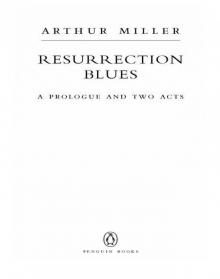 Resurrection Blues
Resurrection Blues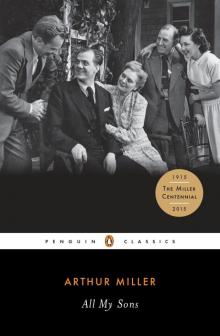 All My Sons
All My Sons The Man Who Had All the Luck
The Man Who Had All the Luck Presence: Stories
Presence: Stories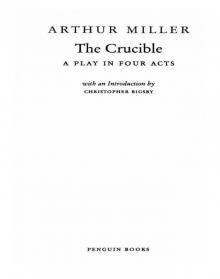 The Crucible
The Crucible Collected Essays
Collected Essays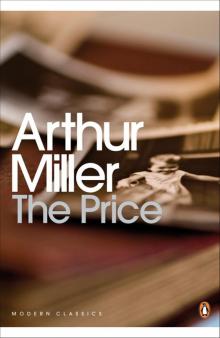 The Price
The Price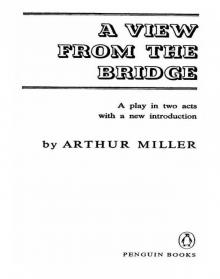 A View from the Bridge
A View from the Bridge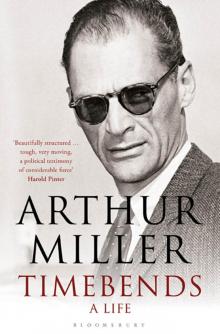 Timebends
Timebends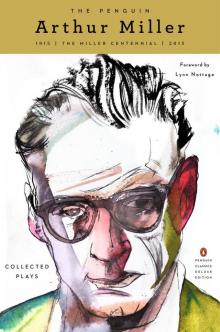 The Penguin Arthur Miller
The Penguin Arthur Miller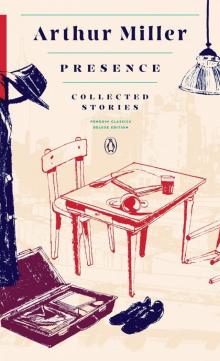 Presence
Presence